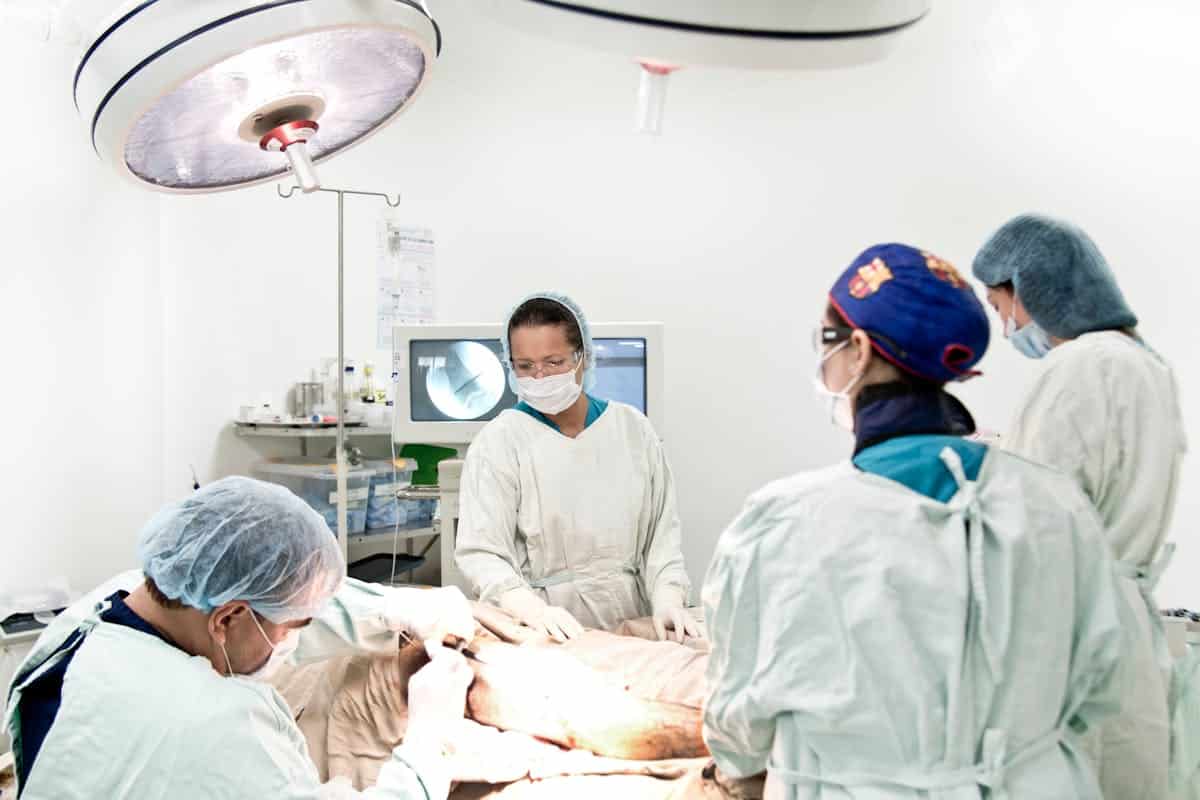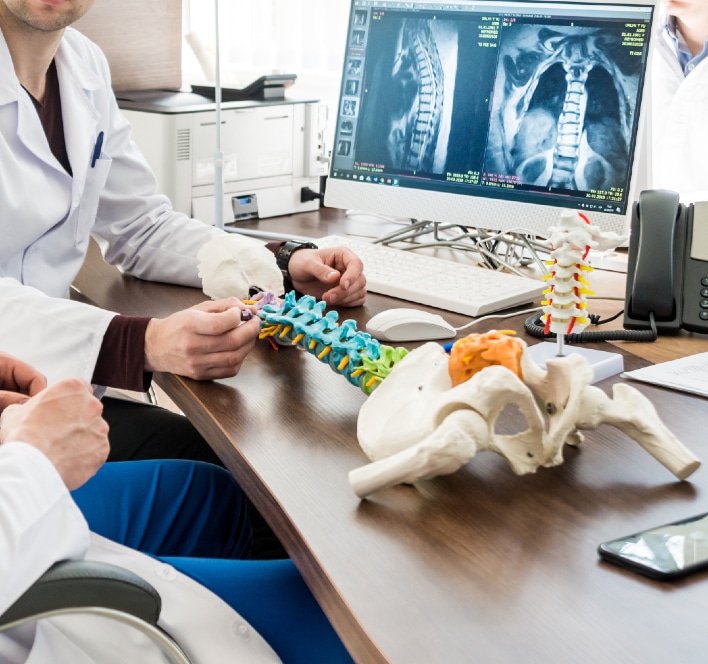Ultrasonic spine surgery, a cutting-edge medical technique, holds promise in revolutionizing the field of spinal procedures by offering unparalleled precision and minimized risks. However, as with all advanced medical practices, it is not without its drawbacks. Potential complications, limitations in treating severe cases, and the substantial financial implications are factors that cannot be ignored. As we evaluate these contrasting aspects, it becomes clear that a thorough understanding of this surgical approach is essential for making informed healthcare decisions.
Understanding Ultrasonic Spine Surgery
What exactly is ultrasonic spine surgery, one might ask? Ultrasonic spine surgery is an innovative medical procedure that uses ultrasonic waves to safely remove spinal pathologies. It is a minimally invasive technique that aims to reduce the risk of nerve damage and blood loss, shorten hospital stays, and speed up patient recovery.
The effectiveness of this surgical approach greatly depends on two key factors: the advancements in ultrasonic device technology and the surgeon’s expertise. Ultrasonic device advancements have led to more precise and safer tools for surgeons. These devices offer the surgeon the ability to selectively target and remove bone, while preserving nearby soft tissue structures. This is a significant improvement over traditional surgical methods, which often involve more extensive tissue dissection and potential damage.
Furthermore, the surgeon’s expertise plays a vital role in the surgery’s success. The surgeon’s understanding of the device’s capabilities, the procedure’s nuances, and the patient’s unique spinal anatomy all play critical roles in ensuring a successful surgery and positive patient outcomes. As ultrasonic spine surgery continues to evolve, it is important that surgeons maintain a high level of proficiency with these devices and the techniques they require.
The Science Behind Ultrasonic Surgery
Delving into the science behind ultrasonic spine surgery, it is essential to understand the role of ultrasonic waves in this advanced medical procedure. Ultrasonic frequencies are harnessed using specialized surgical instruments to perform precise cuts and coagulate blood vessels during spine surgery.
- Ultrasonic waves are sound waves with frequencies above the range of human hearing, typically above 20,000 Hz. These high-frequency waves have the ability to agitate physical matter, a property that has been leveraged in medicine.
- Surgical instruments designed for ultrasonic spine surgery are equipped with a transducer. This device transforms electrical energy into mechanical oscillations, creating the ultrasonic frequencies.
- The ultrasonic frequencies generated by the transducer cause the surgical tip of the instrument to oscillate at an extremely high speed. This rapid movement allows for precise cutting and coagulation of tissues.
- The effect of ultrasonic frequencies on tissues is selective. The oscillating surgical tip can easily disrupt fibrous tissue structures while preserving elastic tissues, making ultrasonic technology ideal for spine surgeries which require a high level of precision.
Pros of Ultrasonic Spine Surgery
Ultrasonic spine surgery, as a minimally invasive technique, offers several significant advantages to take into account. The primary benefits include substantially reduced hospitalization duration, thereby minimizing the overall medical expenses for patients. Additionally, it fosters a faster recovery timeframe, thereby enabling patients to resume their normal activities more quickly than traditional surgery methods.
Minimal Invasive Technique Benefits
Often employed for its numerous advantages, the minimal invasive technique of ultrasonic spine surgery offers significant benefits to patients, especially with regards to recovery time and post-operative discomfort. This is largely due to surgical tool innovation and patient comfort considerations.
- Surgical Tool Innovation: Ultrasonic technology enables precise cutting and removal of bone while preserving soft tissues, reducing risks of damage to surrounding structures.
- Patient Comfort Considerations: The procedure involves smaller incisions which cause less trauma, leading to reduced pain and discomfort post-surgery.
- Reduced Risk of Infection: Smaller incisions minimize exposure to potential sources of infection, thereby lowering the chances of post-operative complications.
- Better Cosmetic Outcome: Smaller scars result from the minimal invasive technique, which can improve a patient’s satisfaction with the surgical outcome.
Reduced Hospital Stay Duration
One significant advantage of ultrasonic spine surgery is the reduction in hospital stay duration, with patients typically able to return home sooner compared to traditional surgical methods. This reduction in hospitalization duration is not only beneficial for the patients’ well-being, but it also has important financial implications.
Shortened hospital stays can lead to a decrease in total hospitalization costs, which can be particularly significant for patients with limited insurance coverage. Moreover, faster discharge allows for quicker post-surgery mobility, which is a critical component of the recovery process. Enhanced mobility stimulates muscle activity and blood circulation, reducing the risk of complications such as deep vein thrombosis. The reduced hospital stay duration associated with ultrasonic spine surgery offers both health and financial benefits.
Faster Recovery Timeframes
Remarkably, patients undergoing ultrasonic spine surgery tend to experience accelerated recovery timeframes, a critical advantage that enhances their postoperative rehabilitation process. This procedure offers the following benefits:
- Reduced Pain: Decreased tissue trauma leads to less postoperative discomfort, promoting post surgery mobility.
- Rapid Rehabilitation: The non-invasive nature of ultrasonic surgery allows patients to initiate their rehabilitation program sooner, aiding in a quicker return to daily activities.
- Enhanced Mental Preparation: Knowing the prospect of a faster recovery can boost a patient’s mental preparation for surgery, reducing anxiety and fostering a positive mindset.
- Decreased Dependency on Medication: Faster healing often reduces the need for prolonged medication use, minimizing potential side effects and complications.
These aspects collectively constitute the major advantages of ultrasonic spine surgery in facilitating faster recovery timeframes.
Enhanced Precision in Surgery
One of the significant advantages of ultrasonic spine surgery is the enhanced precision it offers. The application of ultrasonic technology in spine surgery responds to the need for increased accuracy, thereby minimizing the risk associated with traditional surgical procedures. This advancement in medical technology allows surgeons to operate with a level of precision previously unattainable, which is an essential factor in complex spine surgeries.
Ultrasonic Technology Accuracy
Harnessing the power of ultrasonic technology, surgeons can now perform spine surgeries with unprecedented accuracy and precision. The efficacy of this approach is influenced by several factors:
- Ultrasonic Frequency Effects: The frequency of the ultrasonic waves used in the operation directly impacts the precision of the procedure. Higher frequencies yield better resolution, thereby enhancing surgical precision.
- Patient Suitability Criteria: Not every patient is a suitable candidate for ultrasonic spine surgery. Patient’s overall health, age, and the severity of their spinal condition are significant determinants.
- Surgeon’s Expertise: The surgeon’s familiarity with the ultrasonic technology is critical to achieving desired surgical outcomes.
- Equipment Quality: The precision and reliability of the ultrasonic surgical instruments greatly impact the accuracy of the procedure.
Therefore, while promising, ultrasonic technology’s accuracy is multifaceted.
Precision in Spine Surgery
Building on the advancements in ultrasonic technology, the scope of precision in spine surgery has been greatly expanded, enhancing both surgical success rates and patient recovery times. The integration of surgical robotics has introduced a new era of precision, enabling surgeons to perform complex procedures with increased accuracy. These robotics, coupled with advanced imaging, provide a real-time, three-dimensional view of the surgical field, allowing for better visualization and navigation during surgery. This level of precision is especially beneficial in spine surgery, where the margin for error is minimal. It allows for the exact placement of implants and minimizes the risk of damaging surrounding tissues. Therefore, the blend of ultrasonic technology with surgical robotics and advanced imaging has revolutionized the field of spine surgery.
Reducing Surgical Risks
The refinement of surgical precision, brought about by the integration of ultrasonic technology and advanced imaging, greatly minimizes surgical risks in spine operations. This increased accuracy has significant implications in reducing potential complications, thereby enhancing patient safety.
- Patient education: Detailed knowledge about the procedure allows patients to understand the risks, benefits and alternatives, promoting informed decision-making.
- Reduced tissue trauma: The precision of ultrasonics minimizes collateral damage to adjacent tissues, reducing postoperative pain and recovery time.
- Lower infection rates: Less invasive surgery reduces exposure to potential pathogens.
- Surgical alternatives: If conventional surgery presents high risks, ultrasonic spine surgery can be a safer alternative.
Thus, the meticulous precision offered by ultrasonic technology plays a pivotal role in mitigating surgical risks, reinforcing its efficacy in spine operations.
Reduced Risk of Nerve Damage
One significant advantage of ultrasonic spine surgery lies in its potential to reduce the risk of nerve damage, a common concern in traditional surgical procedures. This innovative surgical technique employs high-frequency ultrasound waves to make precise incisions, minimizing the chance of inadvertent damage to the surrounding nerves.
This precision is paramount in improving nerve healing speed. A reduced likelihood of nerve damage enhances the body’s natural healing process, guaranteeing a more efficient recovery. Additionally, the use of ultrasonic technology mitigates the risk of long-term neurological complications, thereby speeding up neurological improvement post-surgery.
Furthermore, ultrasonic spine surgery allows for better visualization of the surgical field. The surgeon can discern and protect crucial structures, reducing the incidence of postoperative neurological deficit. This visibility, coupled with the precision of the ultrasonic device, ensures a safer surgical environment, especially in complex spine surgery where even a minute error can result in significant neurological damage.
In essence, ultrasonic spine surgery’s key advantage lies in its precision, which reduces the risk of nerve damage. This can lead to enhanced nerve healing speed and faster neurological improvement, making it a viable alternative to traditional surgical procedures for patients and physicians alike.
Faster Recovery Times
One of the prominent advantages of ultrasonic spine surgery is its potential for faster recovery times, which can be attributed to several factors. The efficiency of ultrasonic surgery often results in shorter operation times, potentially leading to less postoperative pain for the patient. Moreover, the reduced rehabilitation period commonly associated with this type of procedure plays a key role in its overall expedited recovery timeframe.
Ultrasonic Surgery Efficiency
An impressive advantage of ultrasonic spine surgery undeniably lies in its potential for markedly expedited patient recovery times. This efficiency can be attributed to a few key factors:
- Ultrasonic Frequency Considerations: The capacity to finely tune ultrasonic frequencies allows for precise, targeted removal of pathological tissue, minimizing collateral damage to healthy structures.
- Patient Eligibility Criteria: Patients with certain conditions or physical constraints may recover more quickly from ultrasonic procedures than traditional methods.
- Minimally Invasive Approach: Ultrasonic surgery typically involves smaller incisions, which generally lead to less postoperative pain and faster healing.
- Reduced Operative Times: The efficiency of the ultrasonic technique often results in shorter surgeries, which can contribute to quicker patient recovery.
These factors collectively underscore the efficiency and potential benefits of ultrasonic spine surgery.
Reduced Rehabilitation Period
Harnessing the power of ultrasonic technology, spine surgery greatly reduces the rehabilitation period, allowing patients to return to their everyday lives more quickly. Ultrasonic technology evolution has enabled surgeons to perform minimally invasive procedures with precision, reducing the trauma to surrounding tissues and resulting in faster recovery times.
The post surgery mobility is notably improved due to the less invasive nature of the surgery. The ultrasonic technology facilitates efficient bone removal and reshaping without causing substantial damage to the surrounding tissues. This allows the patient to commence rehabilitation exercises sooner and regain their strength and mobility more quickly. Therefore, the reduced rehabilitation period is a significant benefit of ultrasonic spine surgery, demonstrating a major advancement in surgical techniques and patient care.
Less Post-Operative Pain
In addition to reducing the rehabilitation period, ultrasonic spine surgery also contributes to less post-operative pain, resulting in faster recovery times for the patient. The impact of this surgical approach on pain management strategies is substantial, improving patient comfort and satisfaction.
- Decreased Analgesic Usage: By minimizing tissue trauma, ultrasonic surgery reduces the need for post-operative analgesics, lowering potential side effect risks.
- Reduced Pain Intensity: Patients typically experience less severe pain, contributing to enhanced mobility post-surgery.
- Faster Return to Daily Activities: Lower pain levels enable quicker resumption of regular activities, improving quality of life.
- Improved Patient Satisfaction: Reduced pain leads to higher patient satisfaction rates, an important measure of a successful surgical outcome.
In essence, ultrasonic spine surgery presents a promising approach to post-operative pain management.
Less Post-Operative Pain
One significant advantage of ultrasonic spine surgery is the reduction in post-operative pain experienced by patients. This benefit is primarily attributable to the minimally invasive nature of the procedure, which limits the amount of tissue damage and inflammation, thereby reducing the pain response.
Pain management techniques are integral to the post-operative phase, and the decreased pain levels associated with ultrasonic spine surgery facilitate more effective management. Reduced pain levels enable patients to commence physical therapy sooner, accelerating their recovery process. This is a critical factor, as early mobilization can prevent complications such as deep vein thrombosis and pulmonary embolism, which are potential risks after any surgical procedure.
In addition to traditional medical strategies, alternative healing approaches can be effectively utilized due to the lower pain levels. These may include methods such as acupuncture, massage therapy, and mindfulness meditation, which can boost the patient’s overall well-being and further assist in their recovery.
Cons of Ultrasonic Spine Surgery
Despite the mentioned benefits, it is crucial to consider that ultrasonic spine surgery, like any other surgical procedure, also has its drawbacks.
- Potential side effects: Ultrasonic spine surgery is a minimally invasive procedure; however, it is not entirely free of potential side effects. Patients may experience mild to severe discomfort post-surgery, along with potential numbness or tingling sensations in the extremities.
- Post surgical care: The need for post-surgical care can be demanding for some patients. This includes regular check-ups, potential physical therapy, and a series of lifestyle modifications to ensure successful recovery.
- Limited applicability: Ultrasonic spine surgery may not be a suitable option for all patients. Those with more complicated spinal conditions, or those who have previously undergone multiple spine surgeries, may not be suitable candidates for the procedure.
- Cost: While less invasive, ultrasonic spine surgery can often be more expensive than traditional spine surgery due to the specialized equipment and training required. This could pose a financial burden to patients without extensive medical insurance coverage.

Potential Surgical Complications
Traversing the intricate landscape of potential complications, it’s essential to understand that ultrasonic spine surgery, while minimally invasive, is not exempt from surgical risks. The surgical arena, despite its advancements, still grapples with infection risks that can manifest post-procedure. These infections can range from superficial incision site infections to deep-seated spinal infections, potentially leading to prolonged hospitalization and additional treatment.
The minimally invasive nature of ultrasonic spine surgery offers a distinct advantage regarding post-operative mobility. The smaller incision and less tissue disruption generally contribute to quicker recovery times. Nonetheless, complications can still arise. Some patients may experience temporary or permanent changes in mobility, which could entail difficulty in walking, numbness, or even paralysis, albeit these are rare.
Furthermore, complications could be related to the ultrasonic device itself. Despite rigorous preoperative checks, mechanical malfunction or failure can result in incomplete fragment removal or inadvertent tissue damage.
Limitations in Treating Severe Cases
While ultrasonic spine surgery exhibits a high degree of efficacy in managing mild to moderate spinal conditions, its applicability becomes greatly restricted when treating severe or complex cases. Several factors contribute to this limitation, including:
- Complication Rates: The risk of complications tends to increase with the severity of the spinal condition. Therefore, despite the minimally invasive nature of ultrasonic spine surgery, it may not be the preferred choice for highly complicated cases where the complication rates may be high.
- Patient Eligibility: Some patients with severe or complex spinal conditions may not be eligible for ultrasonic spine surgery. Factors such as age, overall health status, and the presence of other medical conditions can affect patient eligibility.
- Technical Challenges: The technical complexity involved in treating severe spinal conditions can limit the utility of ultrasonic techniques. Severe cases often require a more invasive approach.
- Limited Research Evidence: There is limited clinical evidence supporting the use of ultrasonic spine surgery in severe cases. Most studies focus on mild to moderate conditions, leaving a gap in knowledge about its effectiveness in severe cases.
In light of these factors, careful patient selection and thorough preoperative assessment are essential in deciding the most suitable surgical approach.
The Cost Aspect
In addition to the clinical considerations and technical limitations of ultrasonic spine surgery, the financial implications of this procedure also demand careful examination. While the procedure’s minimally invasive nature may suggest lower costs, the reality can be more complex, largely due to the highly specialized equipment and training required.
Insurance coverage for ultrasonic spine surgery varies across providers and plans, largely due to the procedure’s relative novelty. Some insurers may categorize it as an experimental or non-standard treatment, limiting coverage or imposing stricter approval criteria. Consequently, patients may face considerable out of pocket expenses, even with insurance.
Costs can also vary widely based on factors such as hospital fees, surgeon’s fees, and the specific nature of the patient’s condition. Additionally, the potential need for additional treatments or extended rehabilitation can add to the overall cost burden.
Despite these financial challenges, it’s important to remember that the true value of ultrasonic spine surgery lies in its potential for improved patient outcomes with fewer complications and shorter recovery times. Patients must, however, be prepared for the potential financial commitment and engage in thorough discussions with their insurance provider and medical team to fully understand the cost implications.
Making an Informed Decision
Deciding whether to undergo ultrasonic spine surgery requires a thorough analysis and understanding of both its potential benefits and associated challenges, ensuring that each patient makes an informed medical decision that suits their unique circumstances and needs.
The decision-making process for such a significant intervention must be detailed and individualized. This involves considering several aspects, including:
- The severity and persistence of the patient’s symptoms, as well as the impact on their quality of life.
- A detailed understanding of the surgery itself, its potential benefits, and the risks involved.
- Patient experiences, particularly those who have undergone the same procedure.
- The patient’s general health status, their ability to withstand surgery, and their readiness for post-operative rehabilitation.
The patient experiences can offer valuable insights into the effectiveness and possible complications of the procedure. However, each patient’s response to the surgery can be unique due to individual health factors and the specific nature of their spine condition.
Frequently Asked Questions
What Is the Average Duration of Ultrasonic Spine Surgery?
The average duration of ultrasonic spine surgery typically ranges from 3 to 5 hours. However, it’s important to take into account additional factors such as surgery costs and recovery expectations, which can greatly influence the overall process.
Can Ultrasonic Spine Surgery Be Combined With Other Treatments?
Yes, ultrasonic spine surgery can be combined with other treatments. However, this may increase ultrasonic surgery risks. Compatibility with alternative treatments should be carefully evaluated by the surgeon for maximum efficacy and patient safety.
How Is the Post-Surgery Rehabilitation Process for Ultrasonic Spine Surgery?
The post-surgery rehabilitation process for ultrasonic spine surgery primarily involves strategic pain management and mobility improvement techniques. These are instrumental in promoting effective healing, restoring function and enhancing the patient’s overall quality of life post-surgery.
Are There Age or Health Restrictions for Ultrasonic Spine Surgery Candidates?
Ultrasonic spine surgery candidates may face age or health restrictions due to surgery risks. Preoperative preparation involves a thorough health evaluation to assess the patient’s suitability for this surgical procedure, considering their overall health status.
Do Insurance Companies Typically Cover Ultrasonic Spine Surgery?
Insurance coverage for ultrasonic spine surgery can have extensive variations. Most insurance companies require pre-approval. It is important to consult with your insurance provider to understand coverage details and any pre-approval necessities.


